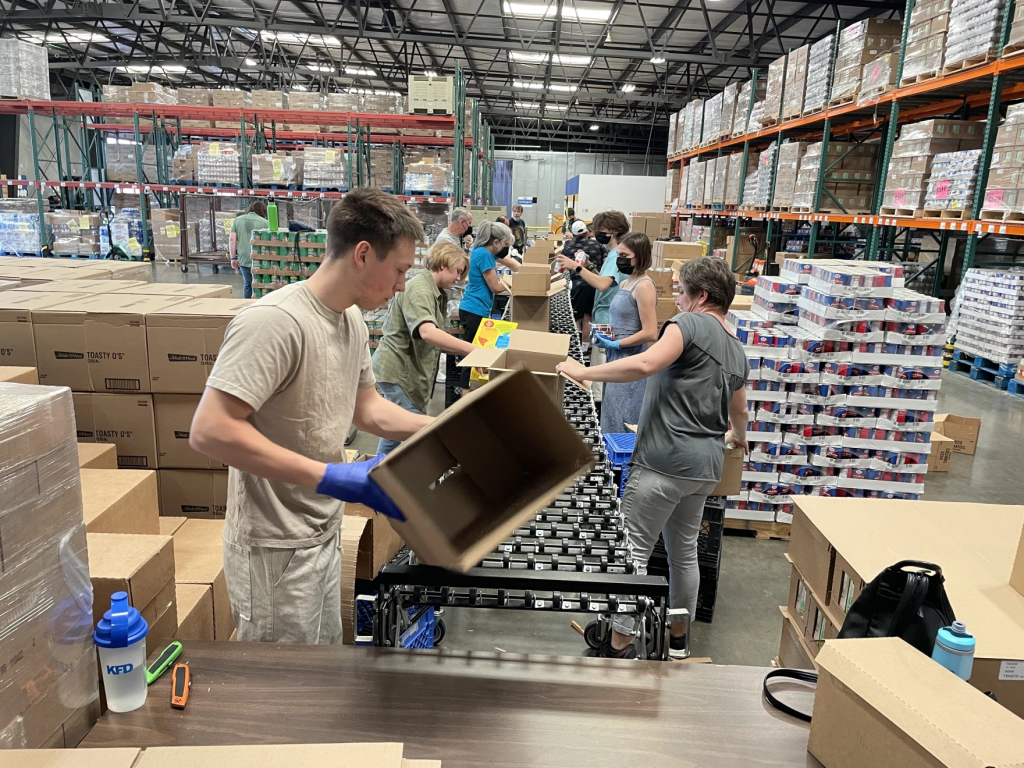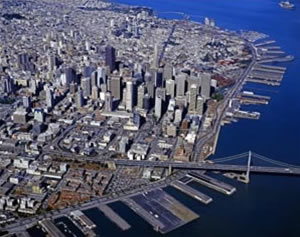
I’m guest hosting today’s Your Call, when we’ll start with a debrief on San Francisco’s election results with the reporting team of Mission Local – and look ahead to 2025.
Daniel Lurie assumes office as San Francisco’s 46th mayor on Jan. 8. He’ll arrive to find a $867 million budget deficit on his doorstep. And that could spike to $1 billion if Trump decides to withhold federal funds promised to the city.
Lurie beat out incumbent mayoral candidate London Breed by 10 percentage points in the second round of ranked choice voting. The new mayor-elect and Levi Strauss heir’s campaign was largely self-funded, and this will be his first time ever holding political office. So what glimpses has he shown the public so far of how he will govern?
Joining us will be Joe Eskenazi, managing editor for Mission Local, and Kelly Waldron, reporter at Mission Local.
Then later in the show, we’ll talk about about rising hunger and a drop in donations to Bay Area food banks. The leaders of 5 major food banks — San Francisco-Marin Food Bank, the Food Bank of Contra Costa and Solano, Second Harvest of Silicon Valley, Redwood Empire Food Bank and Alameda County Community Food Bank — held a joint press conference last week. Together, those organizations provided enough food for 270-million meals last year.
We’ll discuss with Lauren Lathan Reid, CEO of the California Association of Food Banks, and Liz Gomez, chief impact officer at the Alameda County Community Food Bank, and 2023 Bay Area Jefferson Award winner.
Tune in at 91.7 FM in the San Francisco Bay Area or stream live at 10am PT. What comments or questions do you have for our guest? Call 866-798-TALK to join the conversation!

Tonight on State of the Bay at 6pm PT, we’ll discuss the neuroscience of pain, pleasure, and addiction with Dr. Anna Lembke, medical director of addiction medicine at Stanford University and author of the new book Dopamine Nation: Finding Balance in the Age of Indulgence.
Plus we’ll get an update from Joe Eskenazi, managing editor of Mission Local, on San Francisco’s broadening corruption scandal and general dysfunction.
And finally we’ll talk with SF Jazz High School All-Star Sean Huang about making music with others during a pandemic. Their new album can be found here.
Tune in tonight at 6pm PT on KALW 91.7 FM in the San Francisco Bay Area or stream live.
What would you like to ask our guests? Post a comment, tweet us @StateofBay or send an email or voicemail to StateofBay@gmail.com. You can call 866-798-TALK with questions during the show!
How has the city of San Francisco changed in the last decade, and what will it look like in the future? On tonight’s City Vision, I’ll host John Rahaim, Planning Director for the City and County of San Francisco, to discuss these questions.

In his 12 years leading the Planning Department, John has tackled issues ranging from the housing shortage to sea level rise. How have politics and environmental regulations impacted urban development in San Francisco? And how is the city managing growth while addressing climate change, transportation infrastructure, and racial equity?
Tune in at 7pm tonight or stream live. You can join the conversation by calling 866-798-TALK or e-mail or text us at cityvisions@kalw.org. You can also reach us by tweeting us at @cityvisionskalw.
 California’s big cities, from San Francisco to Los Angeles, have been struggling to contain spiraling housing costs, leading to an economic squeeze on the middle class, gentrification and displacement of low-income areas, and overall income inequality.
California’s big cities, from San Francisco to Los Angeles, have been struggling to contain spiraling housing costs, leading to an economic squeeze on the middle class, gentrification and displacement of low-income areas, and overall income inequality.
The debates that have raged in response, however, have been largely untethered from common and accepted data about what is actually causing the increases. Affordable housing advocates want limits on new development and more subsidies for low-income housing, arguing that adding to the supply will simply encourage more displacement. Renter advocates meanwhile want more construction overall to boost the supply and stabilize prices for everyone.
In an impressive display of independent scholarship, Eric Fischer at the blog Experimental Geography stepped into this data void. After pouring over apartment ads in the City of San Francisco since the 1940s, as well as other economic data, he figured out how to predict rents in the city in any given year.
The bottom line: the three big factors are jobs, salaries, and housing supply:
[I]t is possible to model year-over-year change in rent in terms of year-over-year change in employment, wages, and housing construction. In this case the best fit says that a 1% increase in employment means a 0.95% increase in rent, a 1% increase in wages means a 1.74% increase in rent, and a 1% increase in the housing stock means a 1.7% decrease in rent. It’s the same basic idea, but the magnitudes are different. I don’t know if it is any more correct than the first model, or if they are both bouncing around within the same uncertainty.
Basically, it boils down to the economy and available housing stock. So if we want to dramatically decrease housing prices to make the city more affordable to a wider range of income groups, here is what Fischer suggests:
Can we roll the clock back 35 years, to when the CPI-adjusted median rent was approximately one third what it is now?
It will be very hard. If the (first) model is correct, it would take a 53% increase in the housing supply (200,000 new units), or an 44% drop in CPI-adjusted salaries, or an 51% drop in employment, to cut prices by two thirds. A steep drop in salaries or employment would also be devastating to the ability of people to afford the new lower prices. It is enough to make you believe Randal O’Toole that affordability can only be achieved by continued outgrowth, as San Francisco could do in the early 1950s.
200,000 new units is an incredibly tall order, given the land constraints and certainly the political opposition to densifying the city at that scale (Fischer describes this concern as relating to “visual stability” of the city). As a result, achieving rent decreases in San Francisco is probably off the table. But rent stability is still achievable. As Fischer assesses:
Therefore, if price stability is the goal, the city and its citizens should try to increase the housing supply by an average of 1.5% per year (which is about 3.75 times the general rate since 1975, and with the current inventory would mean 5700 units per year). If visual stability is the goal instead, prices will probably continue to rise uncontrollably.
Fischer’s work is a big contribution to the debate and ultimately reinforces the notion that improving housing supply is our best bet for stabilizing rents. But his study does not address the regional forces at work. San Francisco is a kind of island, stuck at the top of a peninsula. So what would the impact be of increasing housing supply across the bay in Oakland, Berkeley, and San Rafael, and then down the peninsula in Silicon Valley? If those areas boosted supply at a significant clip, would that have a similar effect in San Francisco of building those 200,000 additional units within the city?
It would be a helpful next step for this research. But in the meantime, we now finally have a good sense of how much price increases are due to the economy and how much due to supply. For that, we can thank Fischer — and hope that he continues on this research path.
With the news that San Francisco is now mandating solar panels on new construction of certain sizable buildings, Brad Plumer over at Vox makes the point that the city could save more carbon emissions by allowing greater housing density:
According to a 2015 report from UCLA, the average person in the city of San Francisco emits just 6.7 metric tons of CO2 per year. By contrast, the average person who lives in the Bay Area emits 14.6 metric tons of CO2 per year. (The national average is about 17 metric tons.) So if San Francisco relaxed its restrictions and enabled, say, an additional 10,000 people to move from elsewhere in the Bay Area to the city, we could expect that to cut 79,000 metric tons of CO2 per year (to a first, crude approximation). This is three times as much CO2 as the solar panel law would save.
 On a related subject, Shane Phillips rails against supposedly pro-environment, liberal coastal enclaves like San Francisco revolting against this kind of housing density:
On a related subject, Shane Phillips rails against supposedly pro-environment, liberal coastal enclaves like San Francisco revolting against this kind of housing density:
According to a 2015 NYU Furman Center report, rents and housing prices have climbed much more rapidly than incomes in places like NY, SF, and LA, while the reverse is true in places like Dallas, Houston, and Atlanta. Even without referring to the data, we’re all painfully aware of how quickly places like D.C. and San Francisco have become out of reach for lower-income, working class, and even many middle class households. This has had a disparate impact on people of color, the elderly, and other disadvantaged or vulnerable populations—and it’s happening in exactly the places that claim to care most about supporting these individuals.
I couldn’t agree more, but with one caveat: we can’t expect a relatively small city like San Francisco to assume all the responsibility for housing new residents in the Bay Area. Given its abundance of transit, it does make sense for the city to assume something like the majority of new growth, but Silicon Valley, Oakland, Berkeley, and anyplace with a BART station needs to step up, too.
Finally, I’ll just note that for those who complain that California makes it unduly difficult to build housing with laws like CEQA, it’s interesting to see how this housing shortage in urban areas is a national phenomenon. Not that reform of state laws isn’t needed, but it puts the problem in perspective.
Back in the 1970s, Los Angeles and San Francisco were at the top of the economic game for cities in America. At the time, the Bay Area was ranked first in income while Los Angeles was fourth.
But since then, Los Angeles has fallen to 25th, while San Francisco has surged, maintaining its top spot.
So what explains the difference? UCLA professor of urban planning Michael Storper and colleagues set about to examine the reasons in the new book The Rise and Fall of Urban Economies: Lessons from San Francisco and Los Angeles.
The book reads like a whodunit, but the bottom line explanation is that business leaders in the Bay Area continued to foster a connectedness and culture of innovation, while Los Angeles business leaders remained siloed and traditional (Storper’s slide show PDF here). Think Steve Jobs radicals mingling with financiers and traditional business leaders in the Bay Area.
The authors credit business organizations like the Bay Area Council for serving as collaborative, idea-sharing hubs for regional business leaders. But I also wonder if the region’s transportation links and business districts played a role. BART and the general centrality of the business districts in the Bay Area, from San Francisco’s financial district to Silicon Valley to downtown Oakland, allow professionals in the Bay Area to more easily congregate and mingle than in the more horizontally dense landscape of Los Angeles.
It’s perhaps another intangible benefit that could be achieved by Los Angeles expanding the Metro Rail network and building more offices near major transit stops.
You can see a snippet from Storper’s recent presentation at the Bay Area Council here:
The headlines this morning from the Bay Area are not looking good, if you’re concerned about California’s woeful lack of housing production, particularly in the coastal metropolitan areas. As I’ve written before, the historic underproduction has led to insane housing and rental prices, extreme gentrification, outlying sprawl, and terrible traffic and air quality problems.
Yet in response to the challenge, we’re seeing more of the same activists attempting to shut down or stunt housing development in the inner core — exactly where we need new housing. First, San Francisco’s board of supervisors narrowly shot down a proposal to put a moratorium on new housing in the Mission District. It’s now likely to go to the ballot. Second, activists shut down an Oakland City Council meeting on a proposed 24-story residential tower. And finally, San Francisco supervisor Jane Kim wants to go to the ballot to shut down the San Francisco Giants mixed-use project next to their ballpark.
All this on the heels of restrictive zoning and ballot challenges that we’ve seen up and down the state, particularly in places like Santa Monica and San Francisco. If local government leaders continue to defer to these opponents, our present environmental and economic challenges will only worsen.
The headline in today’s San Francisco Chronicle was promising: “Mayor Lee takes steps to keep families in S.F.” But then I read the details:
Mayor Ed Lee took steps Tuesday to make San Francisco a little more family friendly and easier to get around, announcing the city would provide funding to help pay for basic preschool for all 4-year-olds in the city and substantially expand its Muni light-rail fleet.
It’s well-known to locals that San Francisco is brutal for young families, but not because of limited pre-school access or crowded Muni trains. It’s simpler than that: the public school system is painfully dysfunctional, with a convoluted lottery system keeps kids from attending their neighborhood schools and instead can send them on hour-long bus trips to far-flung neighborhoods. And on top of that, the city’s notoriously high cost of housing, due in part to local opposition to and restrictions on residential growth, is even worse for families with kids that need multiple-bedroom homes.
The result is evident from this Chronicle write-up of the last U.S. Census:
Just 13.4 percent of San Francisco’s 805,235 residents are younger than 18, the smallest percentage of any major city in the country. By contrast, San Jose’s percentage of children is 24.8 percent, Oakland’s is 21.3 percent, Boston’s is 16.8 percent and Seattle’s is 15.4 percent, according to Brian Cheu, director of community development for the Mayor’s Office of Housing. Even Manhattan is composed of roughly 15 percent children, according to Dan Kelly, director of planning for San Francisco’s Human Services Agency.
In 1970, children made up 22 percent of San Francisco. In 1960, they constituted 25 percent.
And so we have a city gentrifying faster than ever before, with a whiter and wealthier family base:
Families that choose to stay tend to be whiter and wealthier than ever, several city officials said. Thirty percent of families with children in San Francisco now earn at least 150 percent of the city’s median income. Those families made up 20 percent of all families with children in the city in 1990.
So while expanded pre-school access and more Muni trains sound nice, let’s not pretend it will do anything to reverse this unfortunate trend. The real action should take place on public school reform and dramatically boosting the supply of family housing in the city. Everything else is window dressing.




